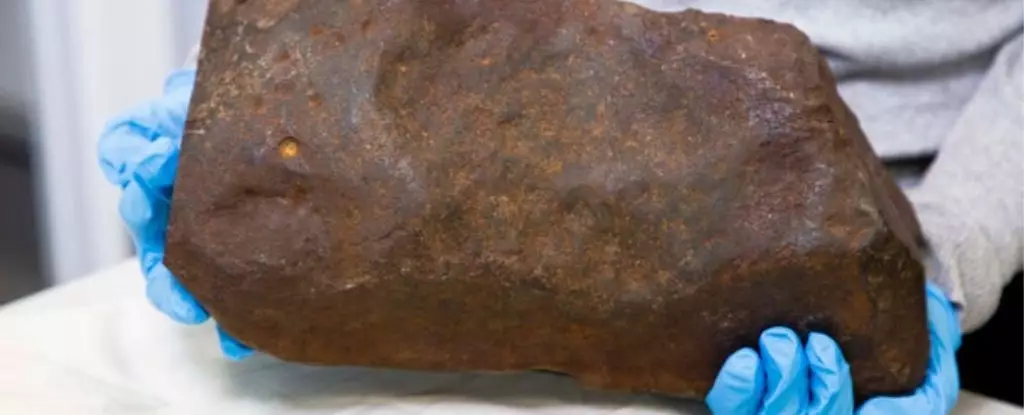In the picturesque expanse of Maryborough Regional Park, located near Melbourne, Australia, an unprecedented event unfolded in 2015 when amateur prospector David Hole stumbled upon an intriguing artifact. Utilizing his trusty metal detector, Hole unearthed a hefty, reddish rock nestled within yellow clay. Believing it to be a promising gold nugget, a notion spurred by the region’s rich history of gold mining during the 19th-century Australian gold rush, he transported his find home, filled with anticipation. However, what followed was a series of arduous attempts to unveil the treasure he imagined lurked within.
Hole employed a comprehensive arsenal of tools, including a rock saw, drill, and angle grinder, even resorting to aggressive tactics with a sledgehammer. Despite his relentless efforts, the rock remained unyielding, refusing to crack. It was a testament to the fact that appearances can be deceptive; the object he was rigorously attempting to open was not a chunk of gold, but rather a rare meteorite.
Years later, Hole’s mysterious stone was identified as a meteorite, and it soon caught the attention of experts at the Melbourne Museum. Renowned geologist Dermot Henry described its distinctive dimpled surface, a hallmark of meteorites that have traversed the atmosphere and undergone intense melting. Under the scrutiny of Henry and his colleagues, what initially appeared to be just another rock was revealed to be significant in our understanding of the universe.
Bill Birch, another Melbourne Museum geologist, highlighted an intriguing physical property of the meteorite—its unusual weight for what ostensibly appears to be a rock found on Earth. This property hinted at its extraterrestrial origins, leading to the publication of a scientific paper detailing the findings. Named the Maryborough meteorite after its discovery location, this object weighed an impressive 17 kilograms (approximately 37.5 pounds) and was classified as an H5 ordinary chondrite due to its high iron content.
Meteorites facilitate an unparalleled glimpse into the cosmos, serving as tangible remnants from the formation of our solar system. They provide vital clues about the history, composition, and evolution of celestial bodies. According to Henry, these objects not only transport scientists back in time but also provide insights into the intricate processes that led to the creation of elements critical for life.
Particularly noteworthy is the potential for some meteorites to contain organic molecules, including amino acids—the fundamental building blocks of life we understand today. The Maryborough meteorite is a valuable specimen, with its age estimated at around 4.6 billion years, making it one of the few rare windowpanes into primeval processes that yielded the conditions necessary for life on Earth.
Though the precise origins of the Maryborough meteorite remain somewhat elusive, scientific speculation suggests its genesis lies within the asteroid belt located between Mars and Jupiter. Astronomical events, such as collisions among asteroids, likely propelled it into space, steering it on a trajectory that ultimately culminated in its arrival on Earth. Through carbon dating methods, researchers speculate that the meteorite has resided on our planet for a period between 100 and 1,000 years, coinciding with recorded meteor sightings spanning from 1889 to 1951.
This serendipitous tale emphasizes the rarity of the Maryborough meteorite, which stands out not only among countless gold nuggets discovered in the region but is also one of only 17 meteorites acknowledged from the state of Victoria. Its significance is underscored by the fact that it ranks as the second largest chondritic mass found in the area, highlighting the extraordinary circumstances leading to its discovery.
The tale of David Hole and his unyielding quest to unveil the secrets of an unsuspecting rock serves as a remarkable reminder of the wonders concealed in the natural world. The discovery of the Maryborough meteorite illuminates the intricate connection between Earth and the cosmos, captivating both scientists and enthusiasts alike. It raises an exciting invitation for others to explore their environments more curiously—who knows what hidden treasures await discovery in our backyards? In a world drenched in gold stories, the saga of the Maryborough meteorite stands as a testament to the rich tapestry of our cosmic history, reminding us that sometimes the most profound value is found not in the shiny allure of gold, but in the whispers of the universe encapsulated in a humble rock.

